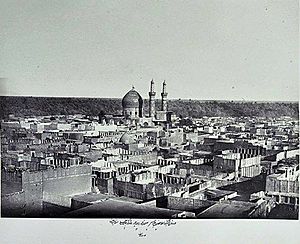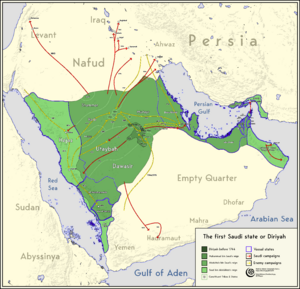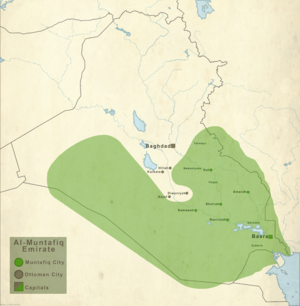Wahhabi sack of Karbala facts for kids
Quick facts for kids Wahhabi sack of Karbala |
|
|---|---|

The shrine of Husayn ibn Ali, Karbala in 1889
|
|
| Location | Karbala, Ottoman Empire |
| Date | April 21, 1802 (or 1801) |
| Target | The shrine of Husayn ibn Ali |
|
Attack type
|
Land army attack |
| Deaths | 2,000–5,000 |
| Victims | Shia inhabitants of Karbala |
| Assailant | Emirate of Diriyah |
|
Number of participants
|
12,000 soldiers |
The Wahhabi sack of Karbala was a major attack that happened on April 21, 1802. Around 12,000 fighters from a group called the Wahhabis, led by Saud bin Abdulaziz, attacked the city of Karbala in what is now Iraq.
During the attack, the Wahhabis killed between 2,000 and 5,000 people living in Karbala. They also looted the important tomb of Husayn ibn Ali. Husayn was the grandson of the Islamic prophet Muhammad. The attackers destroyed the dome of the tomb and took a huge amount of valuable items. These items included gold, expensive Persian carpets, money, pearls, and guns. Many of these treasures had been donated to the tomb over many years. The attack lasted for about eight hours. After that, the Wahhabis left the city with over 4,000 camels carrying all their stolen goods.
Contents
Why the Attack Happened
The Wahhabis followed strict religious teachings. They believed that some practices of Shia Muslims, like visiting and honoring the graves of holy figures, were wrong. They called these practices "Bid‘ah," which means new or forbidden innovations.
Karbala was known to be a very wealthy city. Its Shia tombs, especially the shrine of Imam Husayn, had collected incredible riches over hundreds of years. These riches included gifts and donations from many people.
Before the attack, there was an agreement between the Ottoman Empire and the Emirate of Diriyah (the Wahhabi state) to keep Hajj pilgrims safe. However, some Iraqi tribes attacked these pilgrim groups. The Wahhabis saw this as a reason to strike back. So, 'Abd al-Azeez, the Wahhabi ruler, launched a big attack. By April 1801, his armies had reached Karbala.
The Attack on Karbala
When Did the Attack Happen?
Most historians agree that the attack on Karbala happened in March or April of 1802. Some earlier reports mentioned 1801, but newer research points to 1802 as the correct date.
How the Attack Unfolded
On a significant day for Shia Muslims, either the anniversary of Ghadir Khum or the 10th day of Muharram (which marks the death of Husayn ibn Ali), Wahhabi fighters led by Saud, the son of Abdulaziz bin Muhammad, attacked Karbala. The Ottoman soldiers who were guarding the city ran away. This left the Wahhabis free to loot the city and the holy shrine. They killed between 2,000 and 5,000 people.
A French writer named Jean-Baptiste Rousseau, who was in Iraq at the time, described the event as "a horrible example of Wahhabis' cruel fanaticism." He wrote that Karbala was famous for its huge wealth. This wealth included silver, gold, and jewels donated to Husayn ibn Ali's shrine. Even treasures brought by Nadir Shah from his India campaign were there. Rousseau said that 12,000 Wahhabis attacked the city, set things on fire, and killed many citizens.
A Wahhabi historian, Uthman ibn Abdullah ibn Bishr, also wrote about the event:
The Muslims scaled the walls, entered the city ... and killed the majority of its people in the markets and in their homes. [They] destroyed the dome placed over the grave of Husayn ibn Ali [and took] whatever they found inside the dome and its surroundings ... the grille surrounding the tomb which was encrusted with emeralds, rubies, and other jewels ... different types of property, weapons, clothing, carpets, gold, silver, precious copies of the Qur'an."
Saud bin Abdulaziz, who led the attack, became known as the 'butcher of Karbala' after this event. The Wahhabis spent almost eight hours plundering the city. The ruler of Iran, Fath-Ali Shah, offered military help to Karbala. However, the Ottomans refused this help. Instead, Iran sent 500 Baluchi families to live in Karbala and help defend it.
What Happened Next

The fall of Karbala was a big defeat for the local Ottoman governor, Buyuk Sulayman Pasha. This made it easier for the Ottoman sultan to remove him from power. The Shah of Persia also criticized him for not being able to stop the Wahhabis.
The attack showed that there wasn't a strong Shia "army" ready to fight against such attacks. It also made the identity of Shia religious scholars (called ulama) stronger. Even though the attack horrified many Sunni scholars, it also gave some new ideas to Sunni thinkers in Baghdad. This led to more tensions between different religious groups.
Soon after, the Saudi ruler Abd al-Azeez was killed in a revenge attack. After his death, the Wahhabis stopped their advances into Iraq for a while.
See also
- Demolition of al-Baqi
- Emirate of Nejd
- List of wars involving Saudi Arabia
- Wahhabi War


